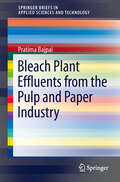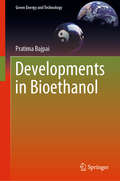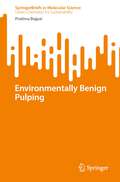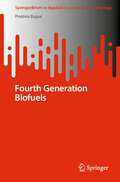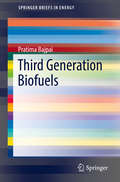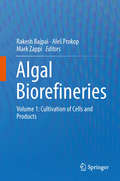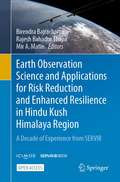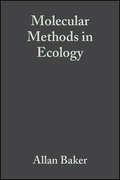- Table View
- List View
Biotechnology for Pulp and Paper Processing
by Pratima BajpaiThis book provides the most up-to-date information available on various biotechnological processes useful in the pulp and paper industry. Each of the twenty chapters covers a specific biotechnological process or technique, discussing the advantages, limitations, and future prospects of the most important and popular processes used in the industry. Topics covered include tree improvement, pulping, bleaching, deinking, fiber modification, biosolids management, and biorefining.
Bleach Plant Effluents from the Pulp and Paper Industry (SpringerBriefs in Applied Sciences and Technology)
by Pratima BajpaiThis book covers bleach plant effluents, that most polluting effluent from the pulp and paper industry. Disappearance of benthic invertebrates, a high incidence of fish diseases, and mutagenic effects on the aquatic fauna are some of the consequences of the disposal of bleach effluents into surface waters. This book describes environmental impact of bleach plant effluents, environmental regulations, and measures to reduce the pollution load by internal process modification and external treatment of bleach plant effluents.
Deep Eutectic Solvents for Pretreatment of Lignocellulosic Biomass (SpringerBriefs in Applied Sciences and Technology)
by Pratima BajpaiThis book focuses on the properties of deep eutectic solvents (DESs) and recent advances in their application in lignocellulosic biomass processing. Lignocellulosic biomass conversion to biofuels, biochemicals and other value-added products has attracted global attention because it is a readily available, inexpensive and renewable resource. However, in order for biomass technologies to be commercially viable, biomass recalcitrance needs to be cost-effectively reduced. Deep eutectic solvents (DESs) are new ‘green' solvents that have the high potential for biomass processing thanks to their low cost, low toxicity, biodegradability, and easy recycling and reuse. After an overview of the current lignocellulosic biomass pretreatment, the book discusses the synthesis and physiochemical properties of DESs, as well as key findings on the effects of DES on cellulose, hemicellulose and lignin solubilization, biomass pretreatment and biomass crystallinity. It then addresses the enzymatic hydrolysis performance of DES-pretreated solids, compatibility of DESs with enzymes and microorganisms, and the recycling potential of DESs. Lastly, it compares DESs with ionic liquids, and examines the challenges and opportunities relating to extending the use of DESs in lignocellulosic processing.
Depolymerization of Lignin to Produce Value Added Chemicals
by Pratima BajpaiEnables readers to convert lignin using a variety of depolymerization methods and develop it into industrially relevant and functional compounds Depolymerization of Lignin to Produce Value Added Chemicals summarizes the depolymerization and utilization of lignin from different sources and covers the emerging field of biological depolymerization, enabling the reader to identify the high added value of a biomass residue and support him/her in its possible use for mass and niche high impact application sectors. Lignin has great potential to significantly improve the economics of a biorefinery due to its conversion into value-added products. To illustrate, this book includes information on: Feasibility of large-scale implementation of covered technologies, including thermal, biological, and chemical depolymerization, especially in relation to potential industrial applications "Lignin-first" biorefining approach, and potential applications of lignin-derived monomers and their derivatives as bioactives in food, natural health products, and pharmaceuticals Business and market scenarios and challenges that intersect with lignin, along with perspectives on lignin valorization Benefits and drawbacks of a lignin-first approach to biorefining, and techno-economic considerations of lignin and its applicationsDepolymerization of Lignin to Produce Value Added Chemicals is an essential resource for researchers, chemists, engineers, analysts, and consultants within universities, independent research organizations, and government.
Depolymerization of Lignin to Produce Value Added Chemicals
by Pratima BajpaiEnables readers to convert lignin using a variety of depolymerization methods and develop it into industrially relevant and functional compounds Depolymerization of Lignin to Produce Value Added Chemicals summarizes the depolymerization and utilization of lignin from different sources and covers the emerging field of biological depolymerization, enabling the reader to identify the high added value of a biomass residue and support him/her in its possible use for mass and niche high impact application sectors. Lignin has great potential to significantly improve the economics of a biorefinery due to its conversion into value-added products. To illustrate, this book includes information on: Feasibility of large-scale implementation of covered technologies, including thermal, biological, and chemical depolymerization, especially in relation to potential industrial applications "Lignin-first" biorefining approach, and potential applications of lignin-derived monomers and their derivatives as bioactives in food, natural health products, and pharmaceuticals Business and market scenarios and challenges that intersect with lignin, along with perspectives on lignin valorization Benefits and drawbacks of a lignin-first approach to biorefining, and techno-economic considerations of lignin and its applicationsDepolymerization of Lignin to Produce Value Added Chemicals is an essential resource for researchers, chemists, engineers, analysts, and consultants within universities, independent research organizations, and government.
Developments in Bioethanol (Green Energy and Technology)
by Pratima BajpaiThis book provides an updated and detailed overview on the recent developments of bioethanol technology. It looks at the historical perspectives, chemistry, sources and production of ethanol and discusses biotechnology breakthroughs and promising developments, its uses, advantages, problems, environmental effects and characteristics. In addition, it presents information about ethanol in different parts of the world and also highlights the challenges and future of ethanol. The first edition of this book was published as a SpringerBriefs in 2013. Since then, many new developments have taken place in the last six years. This new edition will highlight the evolution in bioethanol development from first-generation production to the futuristic fourth-generation bioethanol production, the various constraints and challenges involved, and the scope for development. This book caters to the audience who are interested in alternative transportation fuels which are both biodegradable and sustainable to the environment.
Environmentally Benign Pulping (SpringerBriefs in Molecular Science)
by Pratima BajpaiThis book provides the most up-to-date and comprehensive information on the state-of-the-art techniques and aspects involved in environment-friendly pulping technologies. Traditional chemical and semi-chemical pulping processes are not environmentally friendly. Therefore, it has become important to look for alternative approaches to mitigate wastewater emissions in the paper industry, by making more stringent regulations to improve environmental conservation. In response to this problem, new raw materials need to be explored to replace traditional choices and also new pulping processes need to be developed based on less polluting, more easily recovered reagents. This book presents new and emerging deep eutectic solvents for lignocellulosic biomass pretreatment, and discusses the effects of deep eutectic solvents on biomass pretreatment and the production of value-added products. It also introduces biotechnological methods of pulping. Biotechnological processes help to make manufacturing processes cleaner and more efficient by reducing toxic chemical pollution and greenhouse gas emissions. Given its scope, this book is of interest to applied chemists, foresters, chemical engineers, wood scientists, along with engineers and researchers involved in the pulp and paper industry as a valuable reference.
Fourth Generation Biofuels (SpringerBriefs in Applied Sciences and Technology)
by Pratima BajpaiThis book examines the background of fourth-generation biofuel production, use of genetically modified microalgae for production of fourth-generation biofuels; cultivation and harvesting of genetically modified microalgae; residue from biofuel extraction; health and environmental concerns of fourth-generation biofuels; regulations on cultivation and processing of the genetically modified algae; carbon dioxide sequestration; water footprint and current status and key challenges. The topic caters to academic researchers and industrial experts, who work in the field of biofuels as source of alternative fuel to achieve environmental and economic sustainability.
Green Chemistry and Sustainability in Pulp and Paper Industry
by Pratima BajpaiThis book features in-depth and thorough coverage of Minimum Impact Mill Technologies which can meet the environmental challenges of the pulp and paper industry and also discusses Mills and Fiberlines that encompass “State-of-the-Art” technology and management practices.The minimum impact mill does not mean "zero effluent", nor is it exclusive to one bleaching concept. It is a much bigger concept which means that significant progress must be made in the following areas: Water Management, Internal Chemical Management, Energy Management, Control and Discharge of Non-Process Elements and Removal of Hazardous Pollutants. At the moment, there is no bleached kraft pulp mill operating with zero effluent.With the rise in environmental awareness due to the lobbying by environmental organizations and with increased government regulation there is now a trend towards sustainability in the pulp and paper industry. Sustainable pulp and paper manufacturing requires a holistic view of the manufacturing process. During the last decade, there have been revolutionary technical developments in pulping, bleaching and chemical recovery technology. These developments have made it possible to further reduce loads in effluents and airborne emissions. Thus, there has been a strong progress towards minimum impact mills in the pulp and paper industry. The minimum-impact mill is a holistic manufacturing concept that encompasses environmental management systems, compliance with environmental laws and regulations and manufacturing technologies.
Management of Pulp and Paper Mill Waste
by Pratima BajpaiPulp and paper mill industries are always associated with the disposal problem of highly contaminated sludge or bio-solids.The development of innovative systems to maximize recovery of useful materials and/or energy in a sustainable way has become necessary.The management of wastes, in particular of industrial waste, in an economically and environmentally acceptable manner is one of the most critical issues facing modern industry, mainly due to the increased difficulties in properly locating disposal works and complying with even more stringent environmental quality requirements imposed by legislation.This book presents a general Introduction on waste management in the pulp and paper industry and contains topics on the generation of waste in pulp and paper mills, waste composition, methods of sludge pre-treatment, processes and technologies for conversion of pulp and paper mill waste into valuable products, waste reduction techniques employed in the pulp and paper Industry worldwide and future trends.
Pretreatment of Lignocellulosic Biomass for Biofuel Production (SpringerBriefs in Molecular Science)
by Pratima BajpaiThe book describes the pretreatment of lignocellulosic biomass for biomass-to-biofuel conversion processes, which is an important step in increasing ethanol production for biofuels. It also highlights the main challenges and suggests possible ways to make these technologies feasible for the biofuel industry. The biological conversion of cellulosic biomass into bioethanol is based on the chemical and biological breakdown of biomass into aqueous sugars, for example using hydrolytic enzymes. The fermentable sugars can then be further processed into ethanol or other advanced biofuels. Pretreatment is required to break down the lignin structure and disrupt the crystalline structure of cellulose so that the acids or enzymes can easily access and hydrolyze the cellulose. Pre-treatment can be the most expensive process in converting biomass to fuel, but there is great potential for improving the efficiency and lowering costs through further research and development. This book is aimed at academics and industrial practitioners who are interested in the higher production of ethanol for biofuels.
Single Cell Protein Production from Lignocellulosic Biomass (SpringerBriefs in Molecular Science)
by Pratima BajpaiThis book focuses on bioconversion of lignocellulosic residues into single-cell protein, which offers an alternative to conventional proteins (such as soybean meal, egg protein or meat protein in animal feed) that is not affected by the climate. It provides an overview of the general uses of lignocellulosic residues and their bioconversion into single-cell protein using microorganisms, as well as the recovery of the valuable by-products. It also explores the benefits and potential drawbacks of single-cell protein, with an emphasis on the economic advantages of such processes. Given its multidisciplinary scope, the book represents a valuable resource for academics and industry practitioners interested in the production of single-cell protein from lignocellulosic residues.
Third Generation Biofuels (SpringerBriefs in Energy)
by Pratima BajpaiGrowing concerns about the rapid depletion of fossil fuel reserves, rising crude oil prices, energy security and global climate change have led to increased worldwide interest in renewable energy sources such as biofuels. In this context, biofuel production from renewable sources is considered to be one of the most sustainable alternatives to fossil fuels and a viable means of achieving environmental and economic sustainability. Although biofuel processes hold great potential to provide a carbon-neutral route to fuel production, first-generation production systems are characterized by considerable economic and environmental limitations. The advent of second-generation biofuels is intended to produce fuels from lignocellulosic biomass, the woody part of plants that does not compete with food production. However, converting woody biomass into fermentable sugars requires costly technologies. Therefore, third-generation biofuels from microalgae are considered to be a viable alternative energy resource, free from the major drawbacks associated with first and second-generation biofuels. This book examines the background of third-generation biofuel production; the advantages of algae over traditional biofuel crops; algal biomass production; algae harvesting and drying methods; production of biofuel from microalgae; and future prospects.
Algal Biorefineries: Volume 1: Cultivation of Cells and Products
by Rakesh Bajpai Aleš Prokop Mark ZappiThis book reviews efforts to produce chemicals and fuels from forest and plant products, agricultural residues and more. Algae can potentially capture solar energy and atmospheric CO2; the book details needed research and legislative initiatives.
Earth Observation Science and Applications for Risk Reduction and Enhanced Resilience in Hindu Kush Himalaya Region: A Decade of Experience from SERVIR
by Birendra Bajracharya Rajesh Bahadur Thapa Mir A. MatinThis open access book is a consolidation of lessons learnt and experiences gathered from our efforts to utilise Earth observation (EO) science and applications to address environmental challenges in the Hindu Kush Himalayan region. It includes a complete package of knowledge on service life cycles including multi-disciplinary topics and practically tested applications for the HKH. It comprises 19 chapters drawing from a decade’s worth of experience gleaned over the course of our implementation of SERVIR-HKH – a joint initiative of NASA, USAID, and ICIMOD – to build capacity on using EO and geospatial technology for effective decision making in the region. The book highlights SERVIR’s approaches to the design and delivery of information services – in agriculture and food security; land cover and land use change, and ecosystems; water resources and hydro-climatic disasters; and weather and climate services. It also touches upon multidisciplinary topics such as service planning; gender integration; user engagement; capacity building; communication; and monitoring, evaluation, and learning. We hope that this book will be a good reference document for professionals and practitioners working in remote sensing, geographic information systems, regional and spatial sciences, climate change, ecosystems, and environmental analysis. Furthermore, we are hopeful that policymakers, academics, and other informed audiences working in sustainable development and evaluation – beyond the wider SERVIR network and well as within it – will greatly benefit from what we share here on our applications, case studies, and documentation across cross-cutting topics.
Converting Power into Chemicals and Fuels: Power-to-X Technology for a Sustainable Future
by Martin BajusCONVERTING POWER INTO CHEMICALS AND FUELS Understand the pivotal role that the petrochemical industry will play in the energy transition by integrating renewable or low-carbon alternatives Power into Chemicals and Fuels stresses the versatility of hydrogen as an enabler of the renewable energy system, an energy vector that can be transported and stored, and a fuel for the transportation sector, heating of buildings and providing heat and feedstock to industry. It can reduce both carbon and local emissions, increase energy security and strengthen the economy, as well as support the deployment of renewable power generation such as wind, solar, nuclear and hydro. With a focus on power-to-X technologies, this book discusses the production of basic petrochemicals in such a way as to minimize the carbon footprint and develop procedures that save energy or use energy from renewable sources. Various different power-to-X system configurations are introduced with discussions on their performance, environmental impact, and cost. Technologies for sustainable hydrogen production are covered, focusing on water electrolysis using renewable energy as well as consideration of the remaining challenges for large scale production and integration with other technologies. Power into Chemicals and Fuels readers will also find: Discussion of recent advances in power-into-x technologies for the production of ethylene, propylene, formic acid, and more Coverage of every stage in the power-into-x process, from power generation to upgrading the final product Thermodynamic, technoeconomic, and life cycle assessment analyses of each major process Power into Chemicals and Fuels is a valuable resource for scientists and engineers working in the petrochemicals and hydrocarbons industries, as well as for all industry professionals in these and related fields.
Converting Power into Chemicals and Fuels: Power-to-X Technology for a Sustainable Future
by Martin BajusCONVERTING POWER INTO CHEMICALS AND FUELS Understand the pivotal role that the petrochemical industry will play in the energy transition by integrating renewable or low-carbon alternatives Power into Chemicals and Fuels stresses the versatility of hydrogen as an enabler of the renewable energy system, an energy vector that can be transported and stored, and a fuel for the transportation sector, heating of buildings and providing heat and feedstock to industry. It can reduce both carbon and local emissions, increase energy security and strengthen the economy, as well as support the deployment of renewable power generation such as wind, solar, nuclear and hydro. With a focus on power-to-X technologies, this book discusses the production of basic petrochemicals in such a way as to minimize the carbon footprint and develop procedures that save energy or use energy from renewable sources. Various different power-to-X system configurations are introduced with discussions on their performance, environmental impact, and cost. Technologies for sustainable hydrogen production are covered, focusing on water electrolysis using renewable energy as well as consideration of the remaining challenges for large scale production and integration with other technologies. Power into Chemicals and Fuels readers will also find: Discussion of recent advances in power-into-x technologies for the production of ethylene, propylene, formic acid, and more Coverage of every stage in the power-into-x process, from power generation to upgrading the final product Thermodynamic, technoeconomic, and life cycle assessment analyses of each major process Power into Chemicals and Fuels is a valuable resource for scientists and engineers working in the petrochemicals and hydrocarbons industries, as well as for all industry professionals in these and related fields.
How Nature Works: the science of self-organized criticality
by Per BakSelf-organized criticality, the spontaneous development of systems to a critical state, is the first general theory of complex systems with a firm mathematical basis. This theory describes how many seemingly desperate aspects of the world, from stock market crashes to mass extinctions, avalanches to solar flares, all share a set of simple, easily described properties."...a'must read'...Bak writes with such ease and lucidity, and his ideas are so intriguing...essential reading for those interested in complex systems...it will reward a sufficiently skeptical reader." -NATURE"...presents the theory (self-organized criticality) in a form easily absorbed by the non-mathematically inclined reader." -BOSTON BOOK REVIEW"I picture Bak as a kind of scientific musketeer; flamboyant, touchy, full of swagger and ready to join every fray... His book is written with panache. The style is brisk, the content stimulating. I recommend it as a bracing experience." -NEW SCIENTIST
Physical Inorganic Chemistry: Principles, Methods, and Models
by Andreja BakacPhysical Inorganic Chemistry contains the fundamentals of physical inorganic chemistry, including information on reaction types, and treatments of reaction mechanisms. Additionally, the text explores complex reactions and processes in terms of energy, environment, and health. This valuable resource closely examines mechanisms, an under-discussed topic. Divided into two sections, researchers, professors, and students will find the wide range of topics, including the most cutting edge topics in chemistry, like the future of solar energy, catalysis, environmental issues, climate changes atmosphere, and human health, essential to understanding chemistry.
Physical Inorganic Chemistry: Reactions, Processes, and Applications
by Andreja BakacThis go-to text provides information and insight into physical inorganic chemistry essential to our understanding of chemical reactions on the molecular level. One of the only books in the field of inorganic physical chemistry with an emphasis on mechanisms, it features contributors at the forefront of research in their particular fields. This essential text discusses the latest developments in a number of topics currently among the most debated and researched in the world of chemistry, related to the future of solar energy, hydrogen energy, biorenewables, catalysis, environment, atmosphere, and human health.
Sigmund Freud and the Jewish Mystical Tradition
by David BakanIn this pioneering work, David Bakan challenges the popular view of Freud as an entirely secular intellectual, schooled in modern culture rather than Jewish traditions. Bakan contends that the father of psychology was profoundly influenced by mystic lore about which he appeared to know very little -- and which represents the antithesis of scientific method.This work is based on the premise that Freudian psychoanalytic theory is largely rooted in the Jewish religion, particularly the mysticism of the kabbala. In a fascinating interpretation of the blend of personality and cultural history, Bakan explains how Freud's Jewish heritage contributed, either consciously or unconsciously, to his psychological theories. The author employs Freud's own distinction between being a Jew and the acceptance of Jewish doctrine to demonstrate the effect of Jewish mysticism in the formation of Freud's technical genius.With its focus on the ways in which Freud was and was not Jewish, this study offers a model example of the problem of Jewish identity -- as embodied by one of the giants of modern science, who professed to be both "infidel" and "Jew."
Process Analytical Technology: Spectroscopic Tools and Implementation Strategies for the Chemical and Pharmaceutical Industries
by Katherine A. BakeevProcess Analytical Technology explores the concepts of PAT and its application in the chemical and pharmaceutical industry from the point of view of the analytical chemist. In this new edition all of the original chapters have been updated and revised, and new chapters covering the important topics of sampling, NMR, fluorescence, and acoustic chemometrics have been added. Coverage includes: Implementation of Process Analytical Technologies UV-Visible Spectroscopy for On-line Analysis Infrared Spectroscopy for Process Analytical Applications Process Raman Spectroscopy Process NMR Spectrscopy: Technology and On-line Applications Fluorescent Sensing and Process Analytical Applications Chemometrics in Process Analytical Technology (PAT) On-Line PAT Applications of Spectroscopy in the Pharmaceutical Industry Future Trends for PAT for Increased Process Understanding and Growing Applications in Biomanufacturing NIR Chemical Imaging This volume is an important starting point for anyone wanting to implement PAT and is intended not only to assist a newcomer to the field but also to provide up-to-date information for those who practice process analytical chemistry and PAT. It is relevant for chemists, chemical and process engineers, and analytical chemists working on process development, scale-up and production in the pharmaceutical, fine and specialty chemicals industries, as well as for academic chemistry, chemical engineering, chemometrics and pharmaceutical science research groups focussing on PAT. Review from the First Edition “The book provides an excellent first port of call for anyone seeking material and discussions to understand the area better. It deserves to be found in every library that serves those who are active in the field of Process Analytical Technology.”—Current Engineering Practice
Process Analytical Technology: Spectroscopic Tools and Implementation Strategies for the Chemical and Pharmaceutical Industries
by Katherine A. BakeevThe use of real or near real time measurement of chemical production process parameters as the basis for achieving control or optimisation of a manufacturing process has wide application in the petrochemical, food and chemical industries. Process analytical chemistry (PAC), or process analytical technology (PAT) as it has recently been called, is now being deployed in the pharmaceutical industry, where it is seen as a technology that can help companies to improve their conformity with manufacturing compliance regulations. The objective of this book is to provide a starting point for implementing process analytical chemistry tools in process monitoring applications or as part of a total quality management system. Written from the perspective of the spectroscopist required to implant PAT tools in a process environment, attention is focussed on measurements that are made "in process" at-line or off-line, providing data on product during manufacture. With chapters covering the key spectroscopic tools, their applications in the pharmaceutical and chemical industries and basic chemometrics, the novice can quickly develop a sound understanding of the most practical technologies and applications. Implementation strategies are fully covered and address some of the critical issues that need to be tackled when setting up a PAT project – including choosing a project with a sound business justification in the first place.
Plant Peroxisomes: Biochemistry, Cell Biology and Biotechnological Applications
by A. Baker I. A. GrahamIn the two decades since the last comprehensive work on plant peroxisomes appeared, the scientific approaches employed in the study of plant biology have changed beyond all recognition. The accelerating pace of plant research in the post-genomic era is leading us to appreciate that peroxisomes have many important roles in plant cells, including reserve mobilisation, nitrogen assimilation, defence against stress, and metabolism of plant hormones, which are vital for productivity and normal plant development. Many plant scientists are finding, and will no doubt continue to find, that their own area of research is connected in some way to peroxisomes. Written by the leading experts in the field, this book surveys peroxisomal metabolic pathways, protein targeting and biogenesis of the organelle and prospects for the manipulation of peroxisomal function for biotechnological purposes. It aims to draw together the current state of the art as a convenient starting point for anyone, student or researcher, who wishes to know about plant peroxisomes.
Molecular Methods in Ecology
by Allan BakerThe incorporation of molecular methods in ecological research has added an exciting new dimension to conventional studies, and opened windows into previously intractable areas of research, at the interface between ecology and genetics. Using these new methods it has now become routine to use genetic markers to study ecological phenomena, from molecular sexing of individuals and parentage of offspring, through to population structure of species and phylogenetic relationships of taxa. These methods have stimulated an explosion of empirical and analytical developments in molecular ecology, which have in turn, increasingly attracted students and professional biologists eager to employ them in their studies. Molecular Methods in Ecology traces the development of molecular ecology by reviewing basic molecular biological techniques and earlier methods such as protein electrophoresis, DNA-DNA hybridisation, restriction analysis of DNA, and DNA fingerprinting. Later chapters review methods using newer classes of markers such as microsatellites, introns, MHC, SSRs and AFLP markers in plants and molecular sexing in animals. The strengths and limitations of methods are discussed and guidance is provided in selecting the most appropriate methods for particular problems in ecology. This book will provide both postgraduates and researchers with a guide to choosing and employing appropriate methodologies for successful research in the field of molecular ecology. Provides up-to-date summaries of the latest molecular approaches in this rapidly expanding field. Gives guidance on the appropriate choice of methods for particular problems in ecology, and their strengths and limitations. Provides brief laboratory protocols for each molecular method and summaries of software available for analysis of data in molecular ecology. Outlines examples of the latest research results from studies of both plants and animals, integrated within the framework of molecular ecology.

